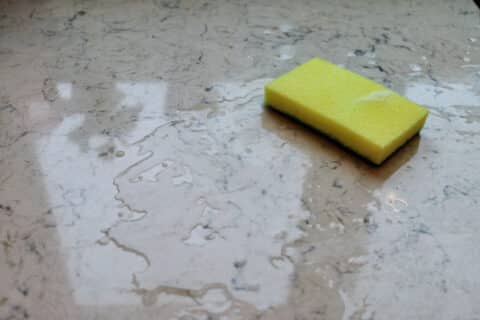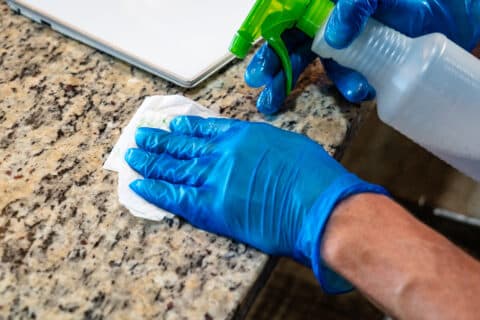How to Remove Stains from Granite Countertops
When it comes to stains in granite countertops, there are a few things you should consider to safely remove them. Granite is a durable and elegant natural stone, but it can be susceptible to stains if not properly maintained. Granite is often used for countertop applications because it can withstand the daily wear-and-tear of kitchen and bathroom messes. However, it is a natural stone that has pores and crevices where liquids can seep in and cause your granite to stain.
Proper maintenance is essential, and preventive measures should be taken to avoid stains and preserve the natural beauty of your granite. Protecting your granite countertops with a stone sealant is critical to avoid stains from penetrating the surface. If a stain occurs in your granite countertop, there are methods and stain removal treatments that can be used to help remove or lift the stain from your stone.
Understanding Granite
Granite is a natural stone that is quarried into slabs and used for multiple purposes. It is one of the strongest and most durable stones with inherent scratch and heat-resistance. Granite is formed and carved from the earth’s surface and composed of different types of sediments and minerals. This creates a coarse-grained stone with naturally occurring pores and fissures.
One of the main characteristics of natural stone is their porosity. This means that they can easily absorb liquids and bacteria if not given a proper and high-end stone sealant. Due to granite’s composition and porous nature, there are common types of stains that affect granite countertops. These include:
- Oil-based stains
- Water stains
- Organic stains (i.e. coffee or wine)
- Acidic stains
- Rust stains
Oil-based Stains
Oil-based stains often occur when cooking oils, grease, or oily substances splash or spill while cooking. These stains create a dark-colored spot and require a specific stain removal treatment.
Water and Organic Stains
Water stains and organic stains are common because they consist of liquids or substances that you use on a regular basis. Coffee, tea, fruit juice, wine, or food are considered organic stains and can become harmful to your countertop depending on the source. Water stains are easier to identify because they create white and cloudy marks, while organic stains vary in color depending on the cause of the stain.
Acidic Stains
Acidic stains are caused by acidic substances such as citrus fruits, vinegar and certain cleaning products. These can become extremely dangerous to natural stones and create etching or dull blemishes.
Rust Stains
Rust stains can result from metal objects, including cans or containers. If these are left on your granite for a prolonged period of time, the rust from the object can transfer onto your granite and cause permanent damage. These stains can be difficult to deal with and require a certain removal technique.
Precautionary Measures
 There are precautionary measures you can take to avoid staining your granite countertops, such as:
There are precautionary measures you can take to avoid staining your granite countertops, such as:
- Immediately clean up any messes or spills
- Use coasters and mats for protection
- Clean your granite countertops regularly or upon use
- Use stone intended cleaners, neutral soaps and a non-abrasive cloth for daily cleaning
It’s important to avoid leaving any liquids or messes behind for too long. If a liquid or substance is left on your granite for an extended period of time, it has more time to absorb moisture and become vulnerable to spots and blemishes being left behind. Any spills should be wiped promptly with a dry and non-abrasive cloth.
Getting into the habit of using coasters, placemats, cutting boards, and protective layers on your stone will also help prevent staining. Placing some type of barrier between your stone and any potentially harmful objects such as a hot, greasy pan or acidic liquid will protect the stone and its sealant. Stone is incredibly durable, but with excessive use, it can wear over-time and become vulnerable to stains.
Granite for countertop applications should be cleaned daily with a special stone-intended cleaner or mild soap. When cleaning your granite, you should remember to use a non-abrasive cloth to avoid any scratches. A stone polisher can be used to maintain and restore the shine of your granite. Taking preventive steps and developing a maintenance routine will help prevent stains in your granite countertops.
Step-by-Step Stain Removal Techniques
If a stain penetrates the surface, there are some stain removal techniques you can try to help lift a stain from your granite countertops. Identifying the source and cause of the stain is necessary to know how to properly treat it. Knowing how the source of a stain affects your granite will help you understand its severity and the best way to remove it. It’s important to keep in mind that grease and oil stains can respond slower to treatments and may require multiple applications or attempts.
As a general guideline for stain removal, a simple poultice can oftentimes be used to lift the stain. There are several different types of poultices that remove different types of stains. Poultices are extremely absorbent substances and can typically be made at home using typical household items. Some poultice recipes will require specific ingredients depending on the type of stain. Here is a simple stone poultice recipe that can be used to treat most stains.
What you will need:
- Hydrogen peroxide – 40% by volume
- Gloves
- Unscented baby powder or talcum powder
- Plastic cup
- Plastic wrap
- Razor blade
- Masking tape
- Plastic putty knife
- Stirrer stick
Steps:
- Pick a test area (approx. 16″x16″) that has the most damage or staining to it.
- Combine the peroxide and the baby powder in the cup and mix until it is a paste about the consistency of peanut butter.
- Apply the paste to the stained area with the putty knife – about 1/4″ thick.
- Cover the area with plastic wrap.
- Tape down the edges using masking tape.
- Use the razor blade to cut one or two slits in the plastic so it can breathe.
- Allow the paste to stay on the counter for 24 hours.
- After 24 hrs., use the plastic putty knife to scrape off the now-dried paste.
- Rinse the work area with water and dry with a paper towel.
- After the surface is completely dry, compare the test space to the rest of the counter and evaluate your progress.
- You should see a distinct difference.
This recipe can always be altered to treat specific types of stains. Oil-based and grease stains, for example, should use a stripper or degreaser to replace the peroxide. A rust stain should substitute in a product called Iron Out, intended to treat rust spots.
The type of stain removal used depends on the source of the stain. Poultice requires a little elbow grease when working on the stain and may require more than one treatment. If the stain is difficult to remove, you should consider other stain removal techniques. Not all stains can be lifted, depending on the severity and how deep it is. Some stains may be more stubborn than others and can require the help of a professional.
DIY vs. Professional Help
 Most poultices can be made at home using simple household items. It’s always recommended to test a small spot on your granite before applying the treatment to the entire stain, depending on its size. If you have any doubts, you should always seek the help of a professional.
Most poultices can be made at home using simple household items. It’s always recommended to test a small spot on your granite before applying the treatment to the entire stain, depending on its size. If you have any doubts, you should always seek the help of a professional.
Depending on the severity of the stain, it may or may not be able to be lifted from a simple poultice solution. In this case, you may need to resort to a stone care professional who can use more technical stain removal techniques. This may involve buffing and polishing the surface, which requires specialized equipment.
Best Practices for Long-Term Maintenance
Natural stone must be given a sealant prior to installation to help prevent staining and artificial damage. A sealant fills the pores in the stone slab to keep liquids and bacteria from easily penetrating the surface. For enhanced protection, regular sealings are recommended for granite countertops, especially if used in high-trafficked areas.
Daily cleaning, weekly polishing and yearly sealings are the best practices for long-term maintenance for your granite countertops.
Granite and Marble Designs Provides the Best Granite Countertops in Denver
Granite and Marble Designs provides design, fabrication and installation for granite countertops. We customize granite countertops to fit your exact space and expectations. We work with the best suppliers and can help you find the granite slab you have envisioned for your project.
Our aim is to achieve customer satisfaction backed by our StoneDoneRight™ Approach where we promise the quality of our product. Our state-of-the-art equipment blended with our years of experience allow us to perfect cuts and edges as well as seam placement.
For quality granite countertops, call Granite and Marble Designs 303-551-6000 or request an appointment.
